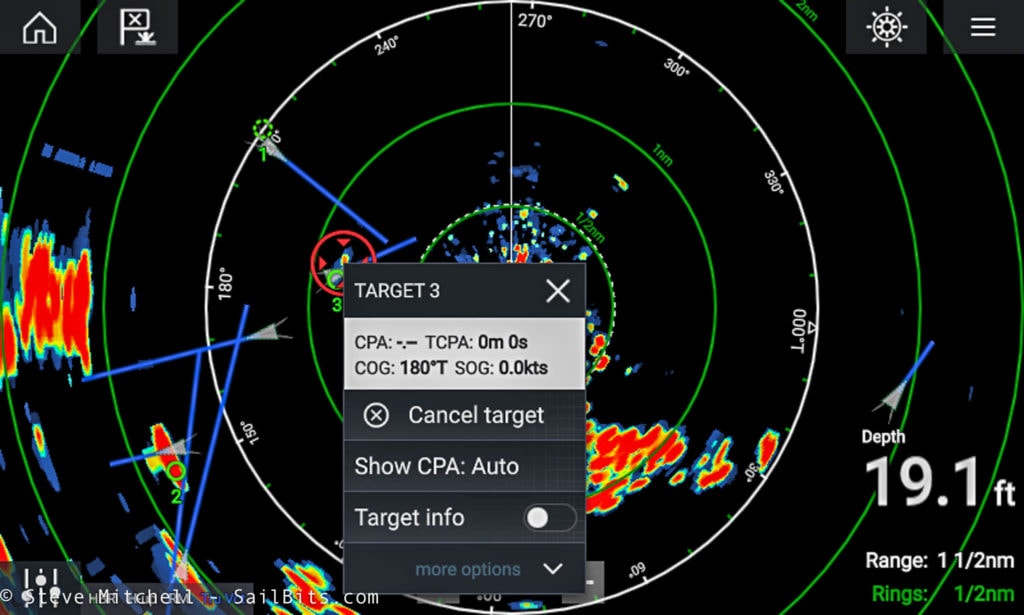Raymarine continue to come out with updates to Lighthouse v3 that include new features and bring forward items from v2. Version 3.3 was released a few weeks ago, and includes support for older eS and gS series MFDs, Navionics Plotter Sync, and new features around radar and sonar. Raymarine has more details on their v3.3 page.
Check out our articles on the initial Axiom review and Lighthouse 3.0, v3.1 autopilot goodness, and v3.2 with Navionics and Fusion audio support, and the latest on v3.4 with apps like Netflix, Spotify, bluetooth support and more.
eS and gS support

One of the most waited for items was Lighthouse v3 support for the older eS and gS model chart plotters. I upgraded my eS75 to v3.3 by downloading the ISO and dumping it onto an SD card. It took a bit for the upgrade to complete, but it was pretty painless. It was somewhat disappointing that only eS and gS models are supported, but that is still quite a breadth of hardware. Many other electronics don’t provide support for that many years in the past – you only have to look at the cell phone and computing industry to see what I mean.
My eS75 runs good with v3.3. It is not as fast as my Axiom, but that is not surprising. I haven’t noticed any issues so far.
Navionics Plotter Sync

I have missed this feature, and am glad to see it was added back to 3.x. I routinely used this with 2.x to update my charts, as well as to sync routes I built on my phone or iPad prior to a trip. With the Axiom not having a front accessible SD card, the chart updates feature is pretty critical to keeping Navionics up to date.

It did fail at least once every time I’ve tried it, so there is some work to be done.
Radar

The radar features have the most updates that I liked. Under settings, you can now add trails which make it very easy to see the past track of targets. You can adjust the length of time for the trails in case you want longer history.

In addition to trails, you can also add vectors for AIS targets and history for targets.

The best feature in my opinion is the ability to add AIS tracked targets to the radar overlay. You can adjust what to show in terms of AIS ships, as well as hide static items. Combine this with trails and history, and you have even more situational awareness of whats around you.

Here’s all of those features enabled at once. You can see AIS ships, blue lines indicating their projected path, and radar echoes and trails under some of the ships as well.

If you designate items as targets using the popup menu, you’ll get even more contextual information on the screen as seen below.

You can see that I marked a couple as targets, and it is now displaying their speed and course. There are two vector lines on both of the targets – I assume one is from AIS, and the other is from the radar side. You’ll also notice there are some ghost markers behind the ship on the left – I’m not 100% sure why there are two “1” markers, one with a solid circle and one with dotted lines. I assume that has something to do with the radar “losing” the contact yet there is still one over the actual contact? I’ll have to experiment more to see what happens.
Nevertheless, these features make radar even more usable and helpful when trying to navigate through busy waters. I love how they combined different types of data instead of keeping them on their own dedicated screens – having it all in one place lets you customize it and have better awareness of what is around you.
Other Updates
Quantum radars are now upgradable via the MFD, which I have been waiting for. Up until v3.3 my radar has been highly unreliable with 3.x due to WiFi disconnect problems. It seems to have gotten better, and I would not be surprised if there is a software upgrade for the radar coming soon, which I will actually be able to perform with this feature being added back to 3.x.
There are a bunch of new sonar updates. I don’t use any of the sonar features but they do look pretty interesting.
You can also display system input voltage as an overlay on a chart or other screen. That is interesting, but not as useful to me as battery voltage, which was already there.
It is great to see the rapid pace of new features and updates, and I look forward to even more in the next few months.

